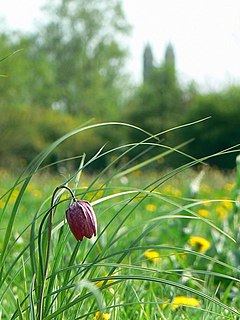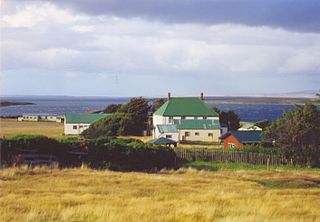
The black turnstone is a species of small wading bird. It is one of two species of turnstone in the genus Arenaria the ruddy turnstone being the other. It is now classified in the sandpiper family, Scolopacidae, but was formerly sometimes placed in the plover family, Charadriidae. It is native to the west coast of North America and breeds only in Alaska.

The blue-winged teal is a species of bird in the duck, goose, and swan family Anatidae. One of the smaller members of the dabbling duck group, it occurs in North America, where it breeds from southern Alaska to Nova Scotia, and south to northern Texas. It winters along the Pacific and Atlantic coasts and south into the Caribbean islands and Central America.

The Cyperaceae are a family of graminoid (grass-like), monocotyledonous flowering plants known as sedges. The family is large, with some 5,500 known species described in about 90 genera, the largest being the "true sedges" genus Carex with over 2,000 species.

The sedge wren is a small and secretive passerine bird in the family Troglodytidae. It is widely distributed in North America. It is often found in wet grasslands and meadows where it nests in the tall grasses and sedges and feeds on insects. The sedge wren was formerly considered as conspecific with the non-migratory grass wren of central and South America.

The southern bog lemming is a small North American lemming. Its range overlaps with the other species in genus Synaptomys, the northern bog lemming, in southeastern Canada, but extends further south.

North Meadow, Cricklade is a hay meadow near the town of Cricklade, in Wiltshire, England. It is 24.6 hectares in size. It is a traditionally managed lowland hay-meadow, or lammas land, and is grazed in common between 12 August and 12 February each year, and cut for hay no earlier than 1 July. This pattern of land use and management has existed for many centuries and has resulted in the species rich grassland flora and fauna present on the site.

Tussock grasses or bunch grasses are a group of grass species in the family Poaceae. They usually grow as singular plants in clumps, tufts, hummocks, or bunches, rather than forming a sod or lawn, in meadows, grasslands, and prairies. As perennial plants, most species live more than one season. Tussock grasses are often found as forage in pastures and ornamental grasses in gardens.

The Cascades ecoregion is a Level III ecoregion designated by the United States Environmental Protection Agency (EPA) in the U.S. states of Washington, Oregon, and California. Somewhat smaller than the Cascade mountain range for which it is named, the ecoregion extends north to Snoqualmie Pass, near Seattle, and south to Hayden Pass, near the Oregon-California border, including the peaks and western slopes of most of the High Cascades. A discontiguous section is located on Mount Shasta in California.

Carex comosa is a species of sedge known as longhair sedge and bristly sedge. It is native to North America, where it grows in western and eastern regions of Canada and the United States, and parts of Mexico. It grows in wet places, including meadows and many types of wetlands. Tolerates deeper water than most common species and is good for retention basins. This sedge produces clumps of triangular stems up to 100 or 120 centimeters tall from short rhizomes. The inflorescence is up to 35 centimeters long and has a long bract which is longer than the spikes. It is a cluster of several cylindrical spikes. The scales over the fruits taper into long, thin awns.

Carex diandra is a species of sedge known by the common names lesser tussock-sedge and lesser panicled sedge.

Carex hassei is a species of sedge known by the common name salt sedge. It is native to western North America from British Columbia to Baja California to New Mexico, where it grows in moist places, such as meadows.

Carex hystericina is a species of sedge known by the common names bottlebrush sedge and porcupine sedge. It is native to much of North America including most of southern Canada and most of the United States. It grows in wet habitat such as wetlands and riverbanks, especially on calcareous soils. In the right conditions it can become very abundant and even weedy. This sedge produces dense or loose clumps of triangular stems up to a meter tall from short rhizomes. The inflorescence is several centimeters long and is accompanied by a bract which is longer than the spikes. The fruits are coated in perigynia with pointed, toothed tips. It is highly recommend for sedge meadow restorations.

Carex leporinella is a species of sedge known by the common name Sierra hare sedge.

Carex microptera is a species of sedge known by the common name smallwing sedge. It is native to western North America, including most all of western Canada and the western United States. It occurs in moist mountain habitat such as meadows and riverbanks. This sedge produces dense clumps of erect stems over 20 centimeters tall and up to about a meter in height. The inflorescence is a dense cluster of green or brown spikes packed tightly and indistinct from each other.

Carex leporina is a species of sedge known in the British Isles as oval sedge and in North America as eggbract sedge. It is native to Eurasia and eastern and western North America, where it grows in seasonally wet habitat, such as meadows and fields. This sedge produces many thin stems and narrow leaves. The inflorescence is an open cluster of several flower spikes. The pistillate flower has a reddish or brownish bract with a gold center and white tip.

Carex praegracilis is a species of North American sedge known as clustered field sedge, field sedge, and expressway sedge. Carex praegracilis is cultivated in the specialty horticulture trade as lawn substitute and meadow-like plantings.

Carex scoparia is a species of sedge known by the common names broom sedge and pointed broom sedge. It should not be confused with the unrelated grass species known as "broom sedge," Andropogon virginicus.

The White Goat Wilderness Area is a provincially designated wilderness area in the Canadian Rockies of Alberta. It was established in 1961 and it, as one of the three wilderness areas of Alberta, has the strictest form of government protection available in Canada. All development is forbidden and only travel by foot is permitted. Hunting and fishing are not allowed. The other two wilderness areas are Ghost River Wilderness Area and Siffleur Wilderness Area and together the three areas total 249,548.80 acres (100,988.82 ha).

Chaceley Meadow is a 1.8-hectare (4.4-acre) biological Site of Special Scientific Interest in Gloucestershire, notified in 1954 and renotified in 1993. It lies on the eastern edge of Chaceley village and is about half a mile west of the River Severn.

Carex bromoides, known as brome-like sedge, brome-sedge, and dropseed of the woods, is a species of sedge in the genus Carex. It is native to North America.




















